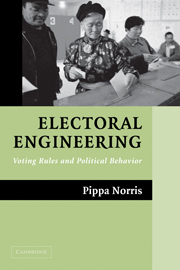Book contents
7 - Turnout
Published online by Cambridge University Press: 05 September 2012
Summary
In many established democracies, concern about eroding participation at the ballot box has been expressed widely, with commentators suggesting that we are seeing the “vanishing voter,” especially in America. Yet patterns of voting turnout in the United States are far from typical and, indeed, always have been during the postwar era. Levels of electoral participation today vary dramatically among democracies. In the countries under comparison, on average more than 80% of the voting age population (VAP) turned out in legislative elections held during the 1990s in Iceland, Israel, and Sweden, compared with less than half of the equivalent group in the United States and Switzerland (see Figure 7.1). The comparison shows that turnout cannot simply be explained by differences in the historical experiences of older and newer democracies, as the Czech Republic, Chile, and South Korea all rank in the top third of the comparison, whereas the United States, Canada, and Japan lag near the bottom. Worldwide there are even greater disparities, with more than 90% of the voting age population (Vote/VAP) participating in legislative elections during the last decade in Malta, Uruguay, and Indonesia, compared with less than a third in Mali, Colombia, and Senegal. To explain these patterns, the first part of this chapter considers accounts based on rational-choice institutionalism and the cultural modernization theories. The second part examines the evidence and analyzes the extent to which turnout varies by political institutions, by electoral laws, and by voting procedures, as well as by the social characteristics and cultural attitudes of voters, and by levels of societal modernization.
- Type
- Chapter
- Information
- Electoral EngineeringVoting Rules and Political Behavior, pp. 151 - 176Publisher: Cambridge University PressPrint publication year: 2004



